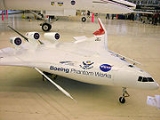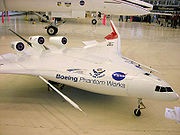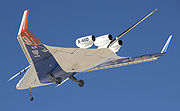
Boeing X-48
Encyclopedia
The X-48 is an experimental unmanned aerial vehicle
(UAV) for investigation into the characteristics of blended wing body
(BWB) aircraft, a type of flying wing
. It is under development by Boeing
and NASA
.
design. It found that passengers did not like the theater-like configuration of the mock-up. The company dropped the design for passenger airliners, but reserved it for military aircraft such as tankers
.
McDonnell Douglas
developed the X-48 concept in the late 1990s, and presented it during an annual Joint AIAA/ASME/SAE
/ASEA Propulsion Conference in 2004. The McDonnell Douglas engineers were confident that their design had all the advantages mentioned, but their concept, code named "Project Redwood" found little favor at Boeing after their merger. The most difficult problem they solved was that of ensuring passengers a safe and fast escape in case of an accident, since emergency door locations were completely different from those in a conventional aircraft.
The blended wing body (BWB) concept offers advantages in structural, aerodynamic and operating efficiencies over today's more conventional fuselage-and-wing designs. These features translate into greater range, fuel economy, reliability and life cycle savings, as well as lower manufacturing costs. They also allow for a wide variety of potential military and commercial applications.
 Boeing Phantom Works
Boeing Phantom Works
is developing the blended wing body aircraft concept in cooperation with the NASA Langley Research Center
. In an initial effort to study the flight characteristics of the BWB design, a remote-controlled propeller-driven blended wing body model with a 17 ft (5.2 m) wingspan was successfully flown in 1997. The next step was to fly the 35 ft (10.7 m) wide X-48A in 2004, but that program was later canceled.
Boeing Phantom Works is focusing current research on a pair of models, called the X-48B, which were built under contract by Cranfield Aerospace in the United Kingdom
. Norman Princen, Boeing's chief engineer for the project, said, "Earlier wind-tunnel testing and the upcoming flight testing are focused on learning more about the BWB's low-speed flight-control characteristics, especially during takeoffs and landings. Knowing how accurately our models predict these characteristics is an important step in the further development of this concept."
The X-48B has a 21 feet (6.4 m) wingspan, weighs 392 pounds (177.8 kg), and is built from composite materials. It is powered by three small turbojet engines and is expected to fly at up to 120 kn (235.2 km/h) and reach an altitude of 10000 feet (3,048 m). The X-48B is a scaled down from a conceptual 240-foot wide design. Though passenger versions of the X-48B have been proposed, the design has a higher probability of first being used for a military transport.
 Wind tunnel
Wind tunnel
testing on a 12 ft wide blended wing body model was completed in September 2005. During April and May 2006, NASA performed wind tunnel tests on X-48B Ship 1, an 8.5% scale model, at a facility shared by Langley and Old Dominion University
. After the wind tunnel testing, the vehicle was shipped to NASA's Dryden Flight Research Center
at Edwards Air Force Base
to serve as a backup to X-48B Ship 2 for flight testing. In November 2006, ground testing began at Dryden, to validate the aircraft's systems integrity, telemetry and communications links, flight-control software and taxi and takeoff characteristics.
 The X-48B first flew on July 20, 2007, reaching an altitude of 7,500 ft (2,286 m); the flight lasting 31 minutes. This began flight testing. The remotely-piloted aircraft was successfully stalled
The X-48B first flew on July 20, 2007, reaching an altitude of 7,500 ft (2,286 m); the flight lasting 31 minutes. This began flight testing. The remotely-piloted aircraft was successfully stalled
for the first time on September 4, 2008, with fixed leading edge slats
, a forward center of gravity
, and 23-degree angle of attack
(2° beyond the maximum coefficient of lift). Stall testing was repeated on September 11 with a NASA pilot at the console.
On March 19, 2010, NASA and Boeing successfully completed initial flight testing of the X-48B. Fay Collier, manager of the ERA Project in NASA's Aeronautics Research Mission Directorate commented on the completion of the first phase of testing saying, "This project is a huge success. Bottom line: the team has proven the ability to fly tailless aircraft to the edge of the low-speed envelope safely."
Following the installation of a new flight computer later this year, the Boeing X-48B will continue a new phase of flights tests that are to focus on additional parameter identification investigations. In addition, the team managing the project is also preparing a second hybrid wing body aircraft: the X-48C for future flight tests, which is intended to have a lower noise profile.
X-48B: Two 8.5% scale aircraft that have been used for flight testing.
X-48C: A modified version of the X-48B.
Unmanned aerial vehicle
An unmanned aerial vehicle , also known as a unmanned aircraft system , remotely piloted aircraft or unmanned aircraft, is a machine which functions either by the remote control of a navigator or pilot or autonomously, that is, as a self-directing entity...
(UAV) for investigation into the characteristics of blended wing body
Blended wing body
Blended Wing Body aircraft have a flattened and airfoil shaped body, which produces most of the lift, the wings contributing the balance. The body form is composed of distinct and separate wing structures, though the wings are smoothly blended into the body...
(BWB) aircraft, a type of flying wing
Flying wing
A flying wing is a tailless fixed-wing aircraft which has no definite fuselage, with most of the crew, payload and equipment being housed inside the main wing structure....
. It is under development by Boeing
Boeing
The Boeing Company is an American multinational aerospace and defense corporation, founded in 1916 by William E. Boeing in Seattle, Washington. Boeing has expanded over the years, merging with McDonnell Douglas in 1997. Boeing Corporate headquarters has been in Chicago, Illinois since 2001...
and NASA
NASA
The National Aeronautics and Space Administration is the agency of the United States government that is responsible for the nation's civilian space program and for aeronautics and aerospace research...
.
Background
Boeing had studied a blended wing bodyBlended wing body
Blended Wing Body aircraft have a flattened and airfoil shaped body, which produces most of the lift, the wings contributing the balance. The body form is composed of distinct and separate wing structures, though the wings are smoothly blended into the body...
design. It found that passengers did not like the theater-like configuration of the mock-up. The company dropped the design for passenger airliners, but reserved it for military aircraft such as tankers
Aerial refueling
Aerial refueling, also called air refueling, in-flight refueling , air-to-air refueling or tanking, is the process of transferring fuel from one aircraft to another during flight....
.
McDonnell Douglas
McDonnell Douglas
McDonnell Douglas was a major American aerospace manufacturer and defense contractor, producing a number of famous commercial and military aircraft. It formed from a merger of McDonnell Aircraft and Douglas Aircraft in 1967. McDonnell Douglas was based at Lambert-St. Louis International Airport...
developed the X-48 concept in the late 1990s, and presented it during an annual Joint AIAA/ASME/SAE
SAE International
SAE International is an organization for engineering professionals in the aerospace, automotive, and commercial vehicle industries. The Society is a standards development organization for the engineering of powered vehicles of all kinds, including cars, trucks, boats, aircraft, and others.SAE...
/ASEA Propulsion Conference in 2004. The McDonnell Douglas engineers were confident that their design had all the advantages mentioned, but their concept, code named "Project Redwood" found little favor at Boeing after their merger. The most difficult problem they solved was that of ensuring passengers a safe and fast escape in case of an accident, since emergency door locations were completely different from those in a conventional aircraft.
The blended wing body (BWB) concept offers advantages in structural, aerodynamic and operating efficiencies over today's more conventional fuselage-and-wing designs. These features translate into greater range, fuel economy, reliability and life cycle savings, as well as lower manufacturing costs. They also allow for a wide variety of potential military and commercial applications.
X-48

Boeing Phantom Works
The Phantom Works division is the advanced prototyping arm of the Defense and Security side of The Boeing Company. Its primary focus is developing advanced military products and technologies, many of them highly classified, and has produced breakthroughs in defense, space and security.Founded by...
is developing the blended wing body aircraft concept in cooperation with the NASA Langley Research Center
Langley Research Center
Langley Research Center is the oldest of NASA's field centers, located in Hampton, Virginia, United States. It directly borders Poquoson, Virginia and Langley Air Force Base...
. In an initial effort to study the flight characteristics of the BWB design, a remote-controlled propeller-driven blended wing body model with a 17 ft (5.2 m) wingspan was successfully flown in 1997. The next step was to fly the 35 ft (10.7 m) wide X-48A in 2004, but that program was later canceled.
Boeing Phantom Works is focusing current research on a pair of models, called the X-48B, which were built under contract by Cranfield Aerospace in the United Kingdom
United Kingdom
The United Kingdom of Great Britain and Northern IrelandIn the United Kingdom and Dependencies, other languages have been officially recognised as legitimate autochthonous languages under the European Charter for Regional or Minority Languages...
. Norman Princen, Boeing's chief engineer for the project, said, "Earlier wind-tunnel testing and the upcoming flight testing are focused on learning more about the BWB's low-speed flight-control characteristics, especially during takeoffs and landings. Knowing how accurately our models predict these characteristics is an important step in the further development of this concept."
The X-48B has a 21 feet (6.4 m) wingspan, weighs 392 pounds (177.8 kg), and is built from composite materials. It is powered by three small turbojet engines and is expected to fly at up to 120 kn (235.2 km/h) and reach an altitude of 10000 feet (3,048 m). The X-48B is a scaled down from a conceptual 240-foot wide design. Though passenger versions of the X-48B have been proposed, the design has a higher probability of first being used for a military transport.

Wind tunnel
A wind tunnel is a research tool used in aerodynamic research to study the effects of air moving past solid objects.-Theory of operation:Wind tunnels were first proposed as a means of studying vehicles in free flight...
testing on a 12 ft wide blended wing body model was completed in September 2005. During April and May 2006, NASA performed wind tunnel tests on X-48B Ship 1, an 8.5% scale model, at a facility shared by Langley and Old Dominion University
Old Dominion University
Old Dominion University is a state university located in Norfolk, Virginia, United States, and is accredited by the Southern Association of Colleges and Schools...
. After the wind tunnel testing, the vehicle was shipped to NASA's Dryden Flight Research Center
Dryden Flight Research Center
The Dryden Flight Research Center , located inside Edwards Air Force Base, is an aeronautical research center operated by NASA. On March 26, 1976 it was named in honor of the late Hugh L. Dryden, a prominent aeronautical engineer who at the time of his death in 1965 was NASA's deputy administrator...
at Edwards Air Force Base
Edwards Air Force Base
Edwards Air Force Base is a United States Air Force base located on the border of Kern County, Los Angeles County, and San Bernardino County, California, in the Antelope Valley. It is southwest of the central business district of North Edwards, California and due east of Rosamond.It is named in...
to serve as a backup to X-48B Ship 2 for flight testing. In November 2006, ground testing began at Dryden, to validate the aircraft's systems integrity, telemetry and communications links, flight-control software and taxi and takeoff characteristics.

Stall (flight)
In fluid dynamics, a stall is a reduction in the lift coefficient generated by a foil as angle of attack increases. This occurs when the critical angle of attack of the foil is exceeded...
for the first time on September 4, 2008, with fixed leading edge slats
Leading edge slats
Slats are aerodynamic surfaces on the leading edge of the wings of fixed-wing aircraft which, when deployed, allow the wing to operate at a higher angle of attack. A higher coefficient of lift is produced as a result of angle of attack and speed, so by deploying slats an aircraft can fly at slower...
, a forward center of gravity
Center of gravity
In physics, a center of gravity of a material body is a point that may be used for a summary description of gravitational interactions. In a uniform gravitational field, the center of mass serves as the center of gravity...
, and 23-degree angle of attack
Angle of attack
Angle of attack is a term used in fluid dynamics to describe the angle between a reference line on a lifting body and the vector representing the relative motion between the lifting body and the fluid through which it is moving...
(2° beyond the maximum coefficient of lift). Stall testing was repeated on September 11 with a NASA pilot at the console.
On March 19, 2010, NASA and Boeing successfully completed initial flight testing of the X-48B. Fay Collier, manager of the ERA Project in NASA's Aeronautics Research Mission Directorate commented on the completion of the first phase of testing saying, "This project is a huge success. Bottom line: the team has proven the ability to fly tailless aircraft to the edge of the low-speed envelope safely."
Following the installation of a new flight computer later this year, the Boeing X-48B will continue a new phase of flights tests that are to focus on additional parameter identification investigations. In addition, the team managing the project is also preparing a second hybrid wing body aircraft: the X-48C for future flight tests, which is intended to have a lower noise profile.
X-48C
A second phase of flight tests with the X-48B was to begin in September 2010. Afterward, the second X-48B will be modified into the X-48C for flight tests in 2011. The X-48C will have its vertical stabilisers moved inboard on either side of the engines, and its fuselage extended aft, both in an attempt to reduce the aircraft's noise profile, and will be powered by two JetCat turbines, each producing 80 pound-force (0.3558577292 kN) of thrust.Variants
X-48A: The initial planned 35 ft (10.7 m) wide version. It was canceled before manufacture.X-48B: Two 8.5% scale aircraft that have been used for flight testing.
X-48C: A modified version of the X-48B.
Specifications (X-48B)
See also
External links
- X-48B page and X-48B images on NASA/DFRC site
- X-48C news
- X-48B page, Cranfield Aerospace
- Boeing X-48B (United States), Unmanned aerial vehicles, Jane's Information Group
- "Boeing Phantom Works to Lead Research on X-48B Blended Wing Body Concept"
- "'Blended wing' craft passes wind-tunnel tests", New Scientist
- "Boeing enters second phase of X-48B flight trials", Flight International
- Boeing X-48B image, BBC
- Jet Cat P200 page, JetCat USA Turbines

